The story so far. From 2002 to 2005, we'd had an avalanche of 'smartphones', depending on when you start counting. I define a smartphone as a phone which has an OS capable of running third party applications, in which case the smartphone world had Symbian OS, in the guise of Nokia with their 'S60' nav-key driven interface, and Sony Ericsson with their touch interface 'UIQ'. Plus a few other Symbian licensees of lesser note. But all could run third party applications - just download them from the web at the time and they installed fine.
Also smartphones were the Windows Mobile-powered full-touch interface 'pocket PCs', almost all made by HTC but badged by other manufacturers. And Handspring (borne of Palm) had launched its Treo series of smartphones running Palm OS.
I loved most of the above, it was a very interesting time in the smartphone world. When you hear other sites talking about how the 'smartphone era started with the Apple iPhone', be aware that they either don't know what they're talking about or are defining 'smartphone' very differently. For example, as something with a capacitive touchscreen, or as something with an on-device third party application store. Even then, there were devices with capacitive touchscreens before the iPhone and Nokia had their 'Download!' Store on their S60 smartphones, plus tie ups with Handango, a centralised store for smartphone apps, long before the iPhone's App Store launch in 2008.
So yes, smartphones galore, but in most cases they weren't that exciting. Either large/heavy, or small, monoblock, and boring. Or folding but fragile plastic, as with the early Nokia Communicators. Or innately fiddly, thinking of the stylus interface on the Treos and UIQ devices.
Which is where our story starts...
| I should note that the phones photographed in this 2021 article are my 'used' replacements gathered over the last few years - my 2006/2007 originals have either been lost or lent to people in need, back in the mists of time - I literally can't remember! Looking back, yes of course I wish I'd kept my originals, which would have still been in pristine condition and probably worth a fortune! |
July 2006. Nokia N93
Not quite out of the blue, since Nokia had done a 'transformer' imaging phone in the Nokia N90, released a year earlier. But the revamped, massively improved N93 was a game-changer for me. Finished in shiny black metal and plastic, the main claim to fame here was a 3MP camera with 3x optical zoom, a relatively huge arrangement and stored in the top-of-device barrel. The photos here should give you an idea. It also shot (cutting edge at the time) VGA video, i.e. 480p, the same as 'DVD quality' in the USA, though slightly under the UK standard, and with high quality stereo sound capture. In opening the N93 for imaging or video work, the form factor was just as for a small camcorder and the experience was... fantastic.

The giant camera - yes, the apertures are small by today's standards, but check out the Z-depth and 3x in-line optical zoom! By the way, below the LED flash and video light are recessed stereo microphones and a plastic cover - under which is a miniSD card slot.
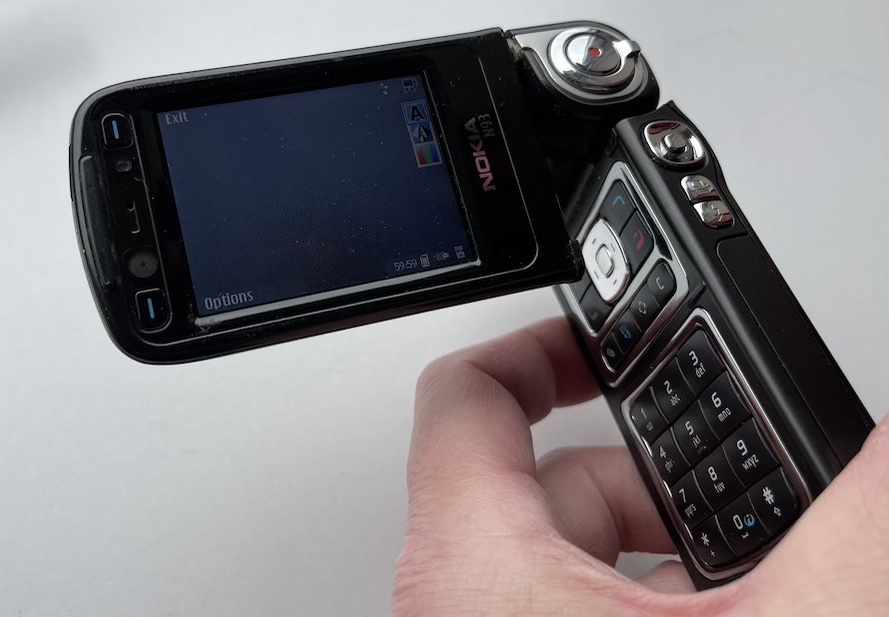
Opened up in transformer/camcorder mode. The Camera app launches automatically. The physical controls down the right are zoom/shutter, a d-pad for selecting modes and gallery photos, a camera/camcorder toggle switch, and a LED/flash toggle.
A few days after getting my N93 (on launch day), I still have fond memories of taking it out on a family trip in the sun to an open-air concert, filming the bands (zooming in video was a revelation, albeit with some motor noise when zooming), and realising that my smartphone could for the very first time completely replace my camcorder (as well as my standalone stills camera). I never used the camcorder again and the tapes are still gathering dust in my loft.
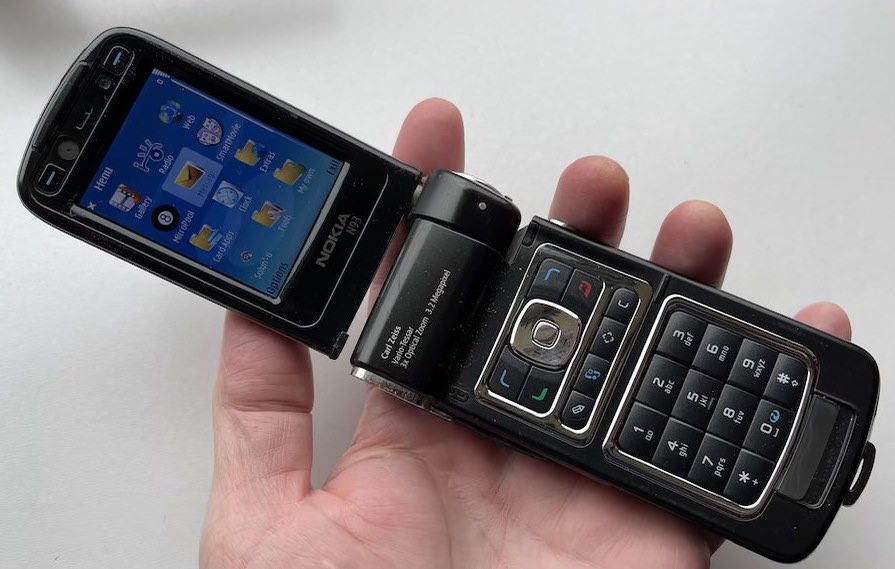
As an unfolded T9 smartphone, the N93 was somewhat large and ungainly, but that misses the point - it's about media - both capture and playback. And a little gaming (see photo below)?
The N93 was flawed in two crucial ways, mind you. I still loved it, but... As with a few other Nokia handsets through the years, the manufacturer cheaped out on RAM, so the N93 booted with only 20MB free, meaning that it would run out of RAM at the slightest provocation. Not good when you're in the midst of filming a Pink Floyd tribute band, in my case! In my open air concert I rebooted the phone about five times! And also recharged it almost as much (from an early power bank) - because the second flaw was that the bulky zoom camera system was quite power hungry. From memory, you got less than an hour's filming on a charge with the initial firmware. Thankfully, the v11 and then v20 firmwares came along* to fix the RAM issue and the smartphone became more useful generally. I took it to several weekend festivals subsequently and it did stirling service.
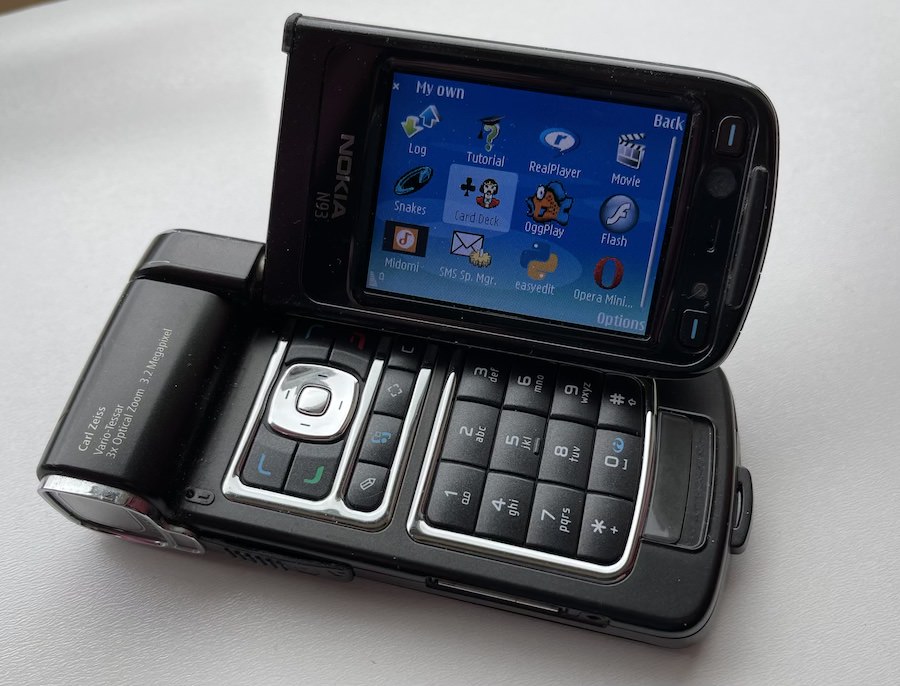
In player mode, perfect with (tiny-screened) videos! And playing third party S60 games, as here!
But even in 2021, the N93 impresses as a piece of phone design. A screen that not only folds open, but then rotates as well, through more than 90º in each direction? An analogue optical zoom control? I could forgive all its quirks and flaws because of its sheer ambition. Think of it as the Surface Duo of its day - except focussed on camera rather than productivity!
*back in 2006 there was no over-the-air update process for ANY smartphone. You had to take the phone to your local service centre! I was on first name terms with my local engineer, trust me.
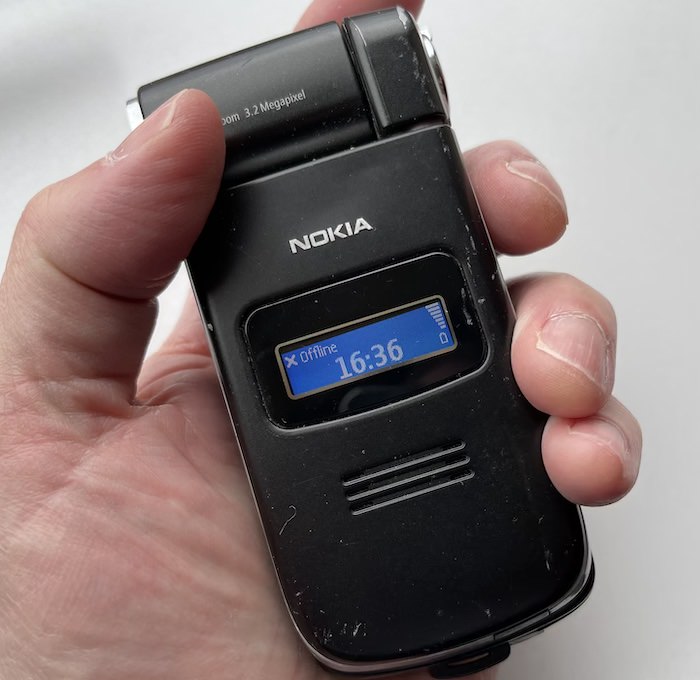
Closed up, the external screen is mainly for time, profile handling, and signal. Plus the odd notification. Note the large loudspeaker grille beneath.
Original AAS links of interest: Review part 1, review part 2.
February 2007. Nokia E90
This was peak All About Symbian and we were in favour, as it were, with the 'old' Nokia. With a little persistence from me and no little negotiation with the Nokia 'E series' chief, I managed to get my hands on a prerelease Nokia E90 Communicator (it formally came out in shops a couple of months later). This was pretty special and it was at the time (and possibly still is) the most converged Symbian device, combining a folding form factor with double-metal hinges that still impress in 2021 with full width display and QWERTY keyboard. Plus super stereo speakers and a better-than-expected focussing camera.

Opened up, the screen stays up securely at several angles, or can be laid flat. Note the wear and tear on this older E90 example, plus some European characters - again, this was donated to my Symbian museum, no idea where it came from!
Mostly metal with some plastic panelling to allow RF through, the Nokia E90 was a beast and, in closed form, able to do double duty as defensive weapon(!) Even 15 years later, most E90s are still going strong, at least in terms of powering up and all components working. The cover display and numeric keypad were a throwback to the early communicators, but it worked really well for triaging incoming messages and calls. If you wanted to be perverse you could open almost any S60 application on the small QVGA outer display, but mostly it was all about the widescreen inner display, with some tweaks to S60 3rd Edition to allow for a 'split screen' interface where needed (e.g. Calendar, Contacts) and with Quickoffice licensed for document duties (it still works in 2021!)
A carry over from Symbian's Psion days and from the early communicators, the shortcut keys (Contacts, Messaging, Web, Notes, etc.) were a real boon, plus there were two custom keys for the apps of your choice (I went for Podcasting and Music). The 3MP rear camera was excellent for its day, far more than you'd expect for a 'business' device, and the stereo speakers, while not spaced far apart, were loud and clear.
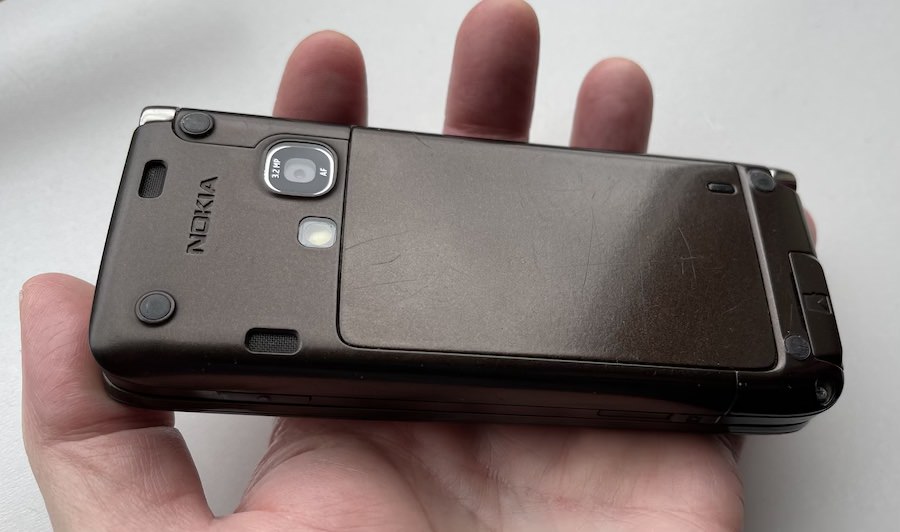
The metal battery cover and 3MP focussing camera (remember, these were days when most phone cameras didn't even focus!) Note also the four rubber feet and the two speaker grilles.
Finally, the use of the famed BP-4L battery meant a full day or two per charge and 30 second battery swaps with a spare from your pocket. Yes, the BP-4L was only 1500mAh, but that was 'hero' status back in 2007 and among the largest in the phone world.
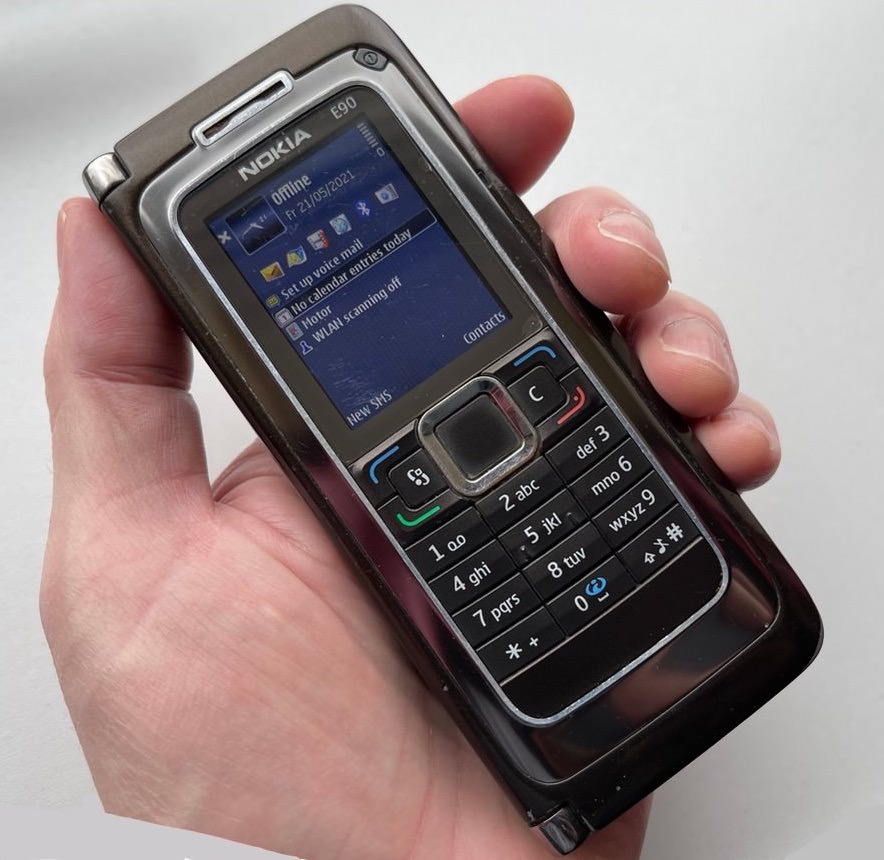
Closed up, the 'cover phone' (actually the same system as for the main display, just with a redrawn/resized UI) was fully useable - on previous communicators, the cover phone was a totally separate system and much more limited.
I adored my E90, even revisiting it in 2010, pimping it to the maximum.
Original AAS links of interest: Early review, Early verdict, many other review parts(!)
August 2007. Nokia N95 8GB
This one needs a little back story. Back in December 2006 I was approached by Nokia's PR people to be one of a few people in the world to try out - and test - the brand new N95. It was hand delivered to me and I duly reported on all the early issues, most of which got fixed. It was, in terms of specs, the prototype of the modern smartphone - GPS, super camera, stereo speakers, 3.5mm out (new at the time!), multimedia control buttons on a dual slide. But the smallish 2.6" display let it down a little, ditto the poor GPS reception for the (then new) in-phone sat-nav (courtesy of Smart2Go, which became Nokia Maps), ditto the appallingly low RAM (see the N93 comment above!), so I was really excited to hear of the launch of a successor just half a year later.
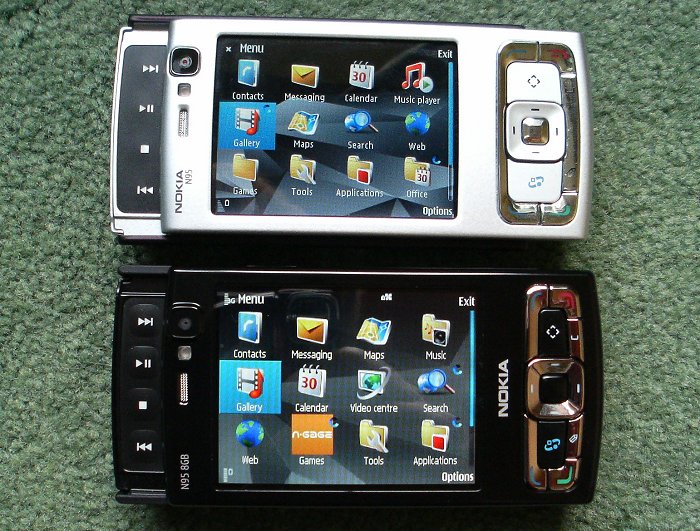
Side by side and media-opened - the original Nokia N95 and the Black Beauty N95 8GB...
The N95 8GB, always in black (and nicknamed 'Black Beauty' here!) was a huge upgrade from the original, with larger and clearer display, fixed up GPS, dramatically more RAM (there are videos online showing 70 or 80 apps running at once), better moulded media keys, and a larger battery to help out.
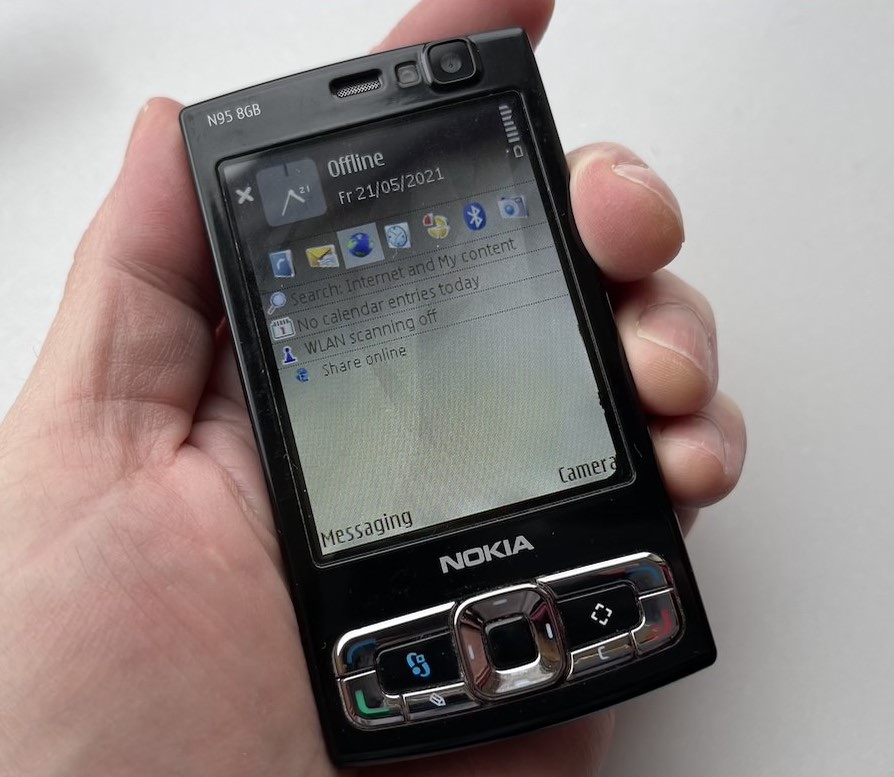
So natural in the hand. A smartphone that just felt 'right' from day one. Perfectly proportioned in every way - for 2007 at least!
The N95 8GB was launched in the UK at the same time as a big N-Gage gaming platform push - I remember that AAS only had the one invite slot and Rafe nabbed it ahead of me. However, the day after the launch was to involve taking the invited bloggers and journalists on a river trip on the Thames, ahead of them all heading home. I turned up and Nokia were fine with me not only tagging along (taking Rafe's place) but also having an N95 8GB for the morning. So I was in the slightly surreal position of having the oh-so-sexy Black Beauty in my hands for a couple of hours, most of which was spent bobbing up and down on the river. The tour guide caught my eye a few times and tried to make me feel guilty for not paying attention to his jokes - all I wanted to do was shout back that I could take his stupid tour anytime and I'd only have this slice of high tech for a few minutes more. (Well, until a few weeks later when review samples were available!)
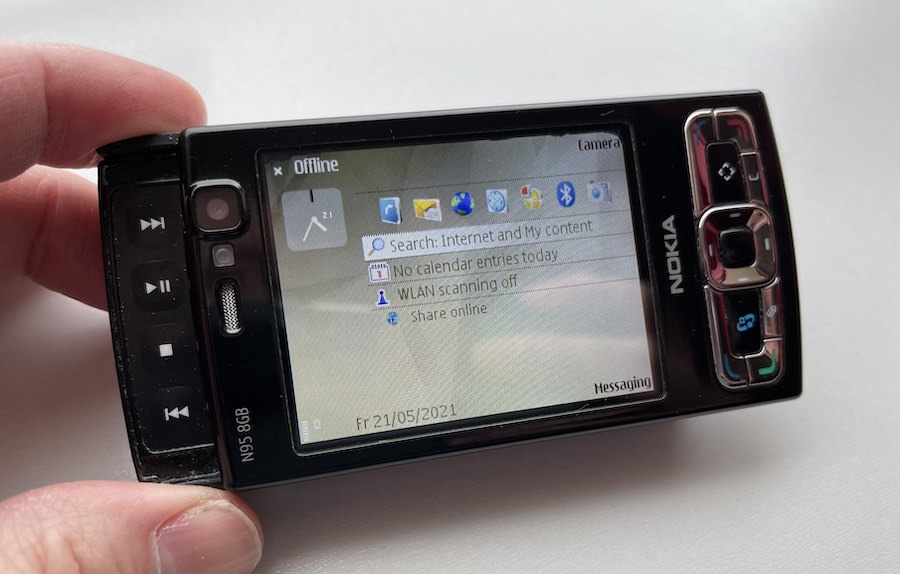
With the media controls slid out to the left. Perfect for podcasts and music, and the mouldings meant that you could find them without looking - though they did light up in the dark anyway! Note the way the interface auto-switches to landscape, even on the homescreen, as with the N93 and E90 above. Try that with a 2021 iOS or Android device...(!)
My first hands-on was enough to make me a believer though. An extra 0.2" on the display diagonal doesn't sound like much, but it was a big deal in the hand, added to display tech improvements to increase contrast and brightness, especially outdoors - the N95 8GB excelled at being a 'go anywhere Swiss Army knife smartphone'.
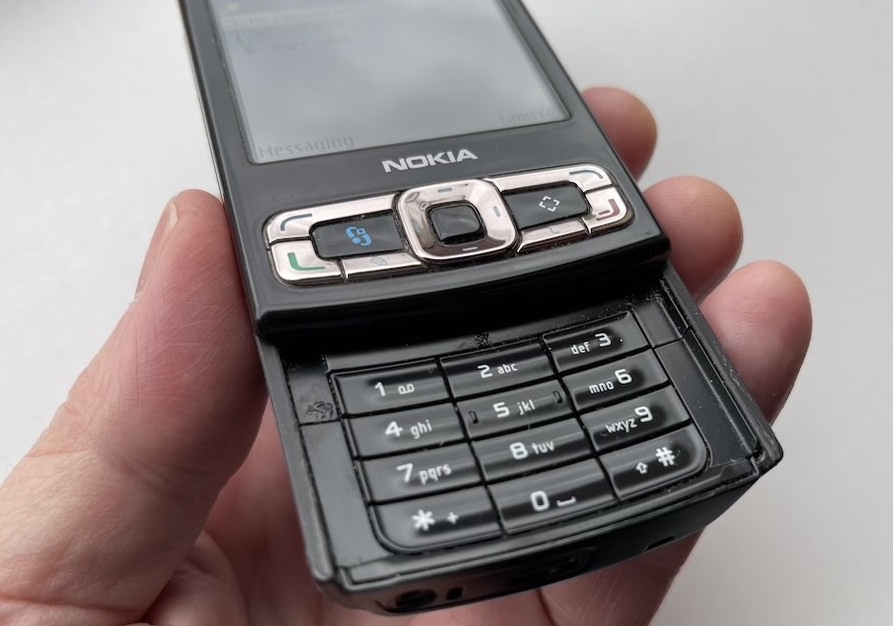
S60's default input was via T9 on a numeric keypad. My muscles can still handle it, curiously!
The only real downside was that the device was a little fatter (the bigger battery) and that storage was integrated - a whopping 8GB - as in modern phones, so it was ahead of its time here, whereas the original N95 had been microSD, so you put in the size required.

Ah yes, the days when battery replacements were trivial. This is the upgraded unit in the N95 8GB. The wiggly thing is the GPS antenna, by the way!
You'll note the timing of the N95 8GB's launch matches that of the original Apple (dumb) iPhone, and I had great fun comparing first this against my N95 8GB (no contest, other than in UI), then in 2008, pitched it against the improved iPhone 3G (closer, but the Nokia still won on sheer specs). For those that are interested, I'd estimate that Apple overtook Nokia in terms of overall flagship capability around 2009, but even then the Nokias were top guns in terms of imaging, of course, one of my passions.
Original AAS links of interest: Unboxing and first impressions, N95 8GB review
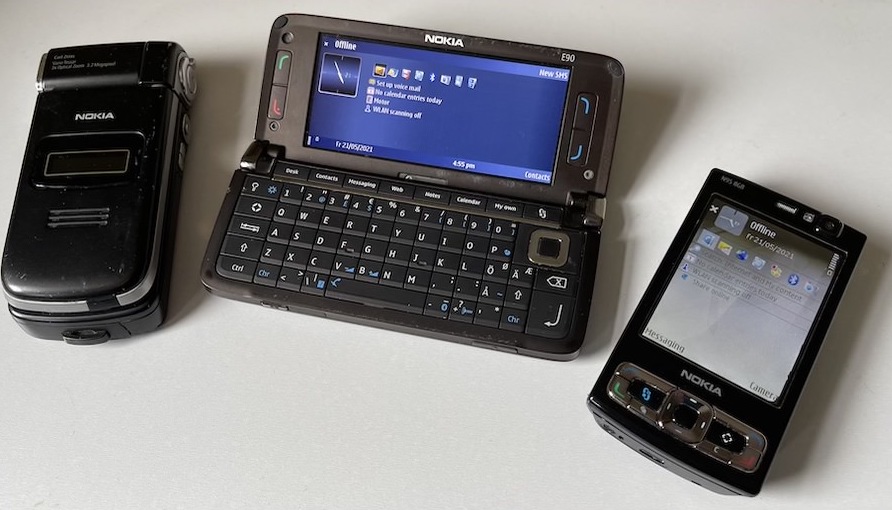
A handsome trio from mid-2006 to mid-2007!!
At the end of 2007 then, I had all three smartphones above in my stable and rather spoiled for choice. In practice, the N93's RAM limits ruled it out for a main device, the E90 remained a favourite but was too big to go everywhere with me. Leaving Black Beauty!
An utterly exciting 12 months for a phone geek, especially one with an interest in Symbian OS. Yes, I had a Treo on the side, yes, I had some of the Windows-powered phones on test for my fledgling Phones Show (which started in January 2006 and is - ahem - still going), but it was the three devices above that really got my tech juices flowing. Was it partly that I was using this tech ahead of almost anyone else in the world? Possibly. But I maintain that these three, in particular, were something special in terms of design.
What about you? Memories from the time? And do you have a similar time period in which your smartphone boundaries got widened?
